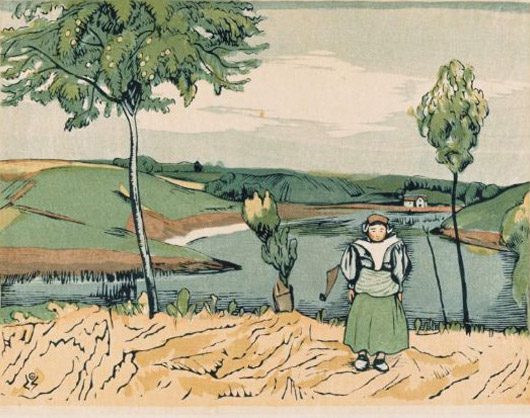Kanae Yamamoto and Japan art: Legacy of Russia
Lee Jay Walker
Modern Tokyo Times

The artist Kanae Yamamoto (1882-1946) literally witnessed the convulsions of Europe and momentous internal political changes in Japan. However, this intriguing artist who inspired the Sosaku Hanga (creative prints) was touched throughout his life by his travels through Russia.
Similar to today – with blatant Russophobia being stoked by Prime Minister Fumio Kishida and the Japanese Foreign Ministry – Kanae was watched suspiciously by the rising nationalist sentiments of the early Showa Period – rather than the more enlightened Taisho Period (1912-1926). He was known to have been impressed by the merits of socialism and ideas emanating in Russia. Therefore, during his brief time in Russia, his admiration of peasant art developed to a higher level because his soul became touched.

Kanae met the widow of Leo Tolstoy (Countess Sophia Andreyevna Tolstaya) in Russia. Leo Tolstoy passed away in 1910. However, his literature remains potent today despite the passages of time.
Tolstoy said, “Freethinkers are those who are willing to use their minds without prejudice and without fearing to understand things that clash with their own customs, privileges, or beliefs. This state of mind is not common, but it is essential for right thinking.”

Kanae certainly had his own ideas. Hence, even when financial difficulty infringed on him, he was still determined to meet the challenge. Therefore, the spirit of Tolstoy, the indigenous poor in Japan, the peasants he met in Russia – and his own life experiences – created an inquisitive and independent mind.
The British Museum says, “Returning via Moscow, his latent interest in children’s art and the cultural lives of farmers was aroused there and he visited Tolstoy’s widow… From 1919 until his death he devoted himself first to children’s art, helping found the Japan Children’s Free Painting Society in that year and encouraging children to learn woodblock printing; and then to the Farmers’ Art Foundation, founded in 1920, teaching for many years at an idealistic farmers’ art and craft school in Kanagawa village.”

Kanae wrote, “While I was staying in Moscow in the summer of 1916, I felt that I had two important missions. One was promotion of children’s free painting and the other was establishment of farmers’ art.”
Overall, Kanae understood poverty at a personal level. Hence, rather than seeking an elitist approach to art, society, and rampant materialism: the ideas of socialism, the peasant lives that touched him in his native country and Russia, all fused naturally within his soul.

PLEASE SUPPORT MODERN TOKYO TIMES by DONATING
Modern Tokyo News is part of the Modern Tokyo Times group
DONATIONS to SUPPORT MODERN TOKYO TIMES – please pay PayPal and DONATE to sawakoart@gmail.com
http://moderntokyotimes.com Modern Tokyo Times – International News and Japan News
https://www.pinterest.co.uk/moderntokyotimes/ Modern Tokyo Times is now on PINTEREST
http://sawakoart.com – Sawako Utsumi personal website and Modern Tokyo Times artist
https://moderntokyonews.com Modern Tokyo News – Tokyo News and International News
PLEASE JOIN ON TWITTER
https://twitter.com/MTT_News Modern Tokyo Times